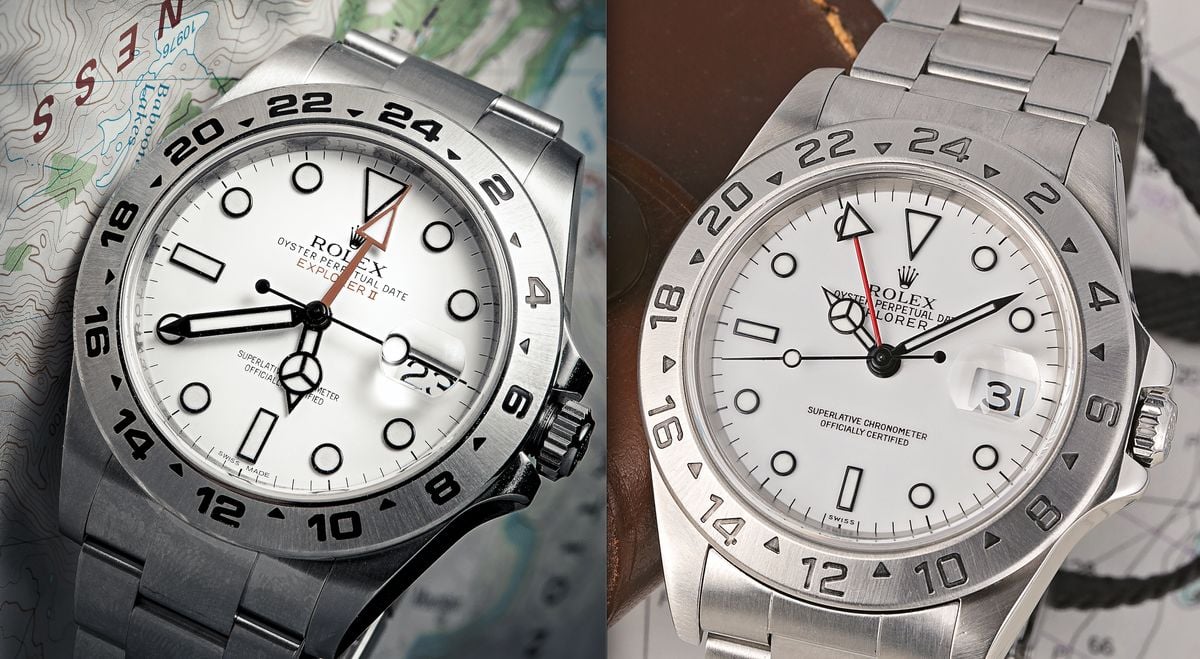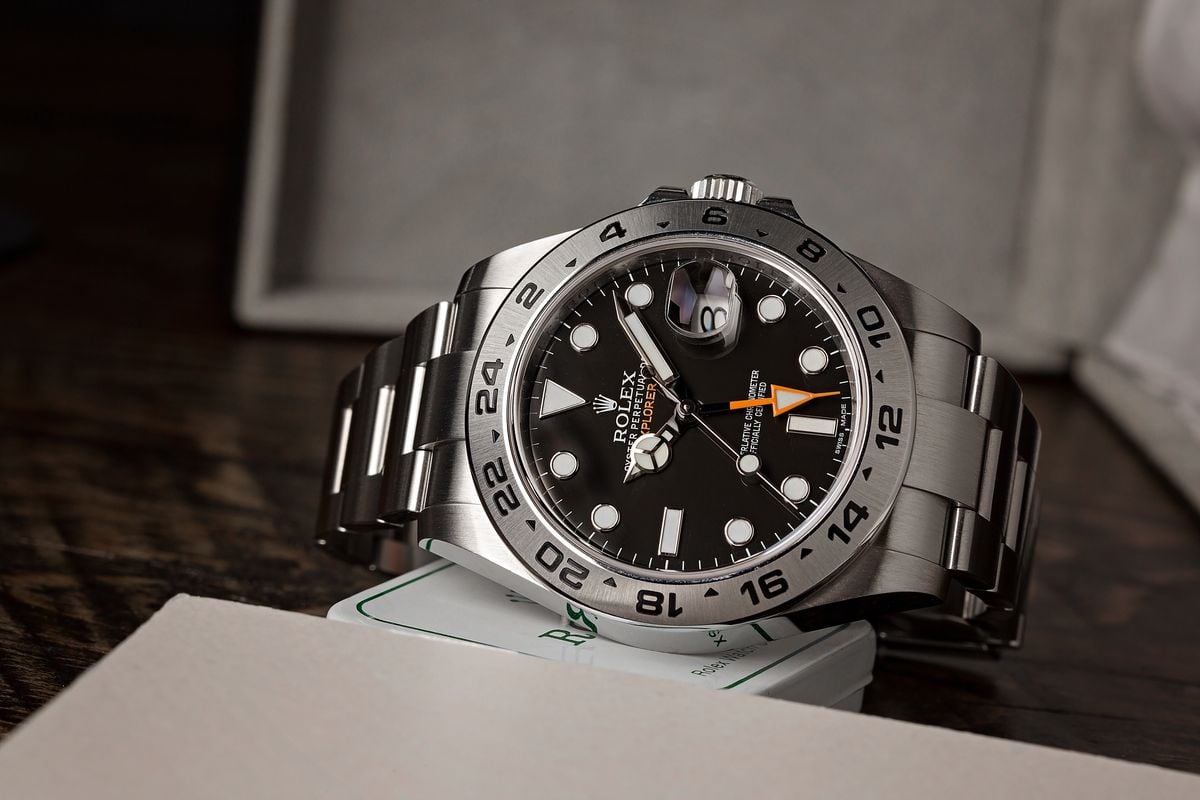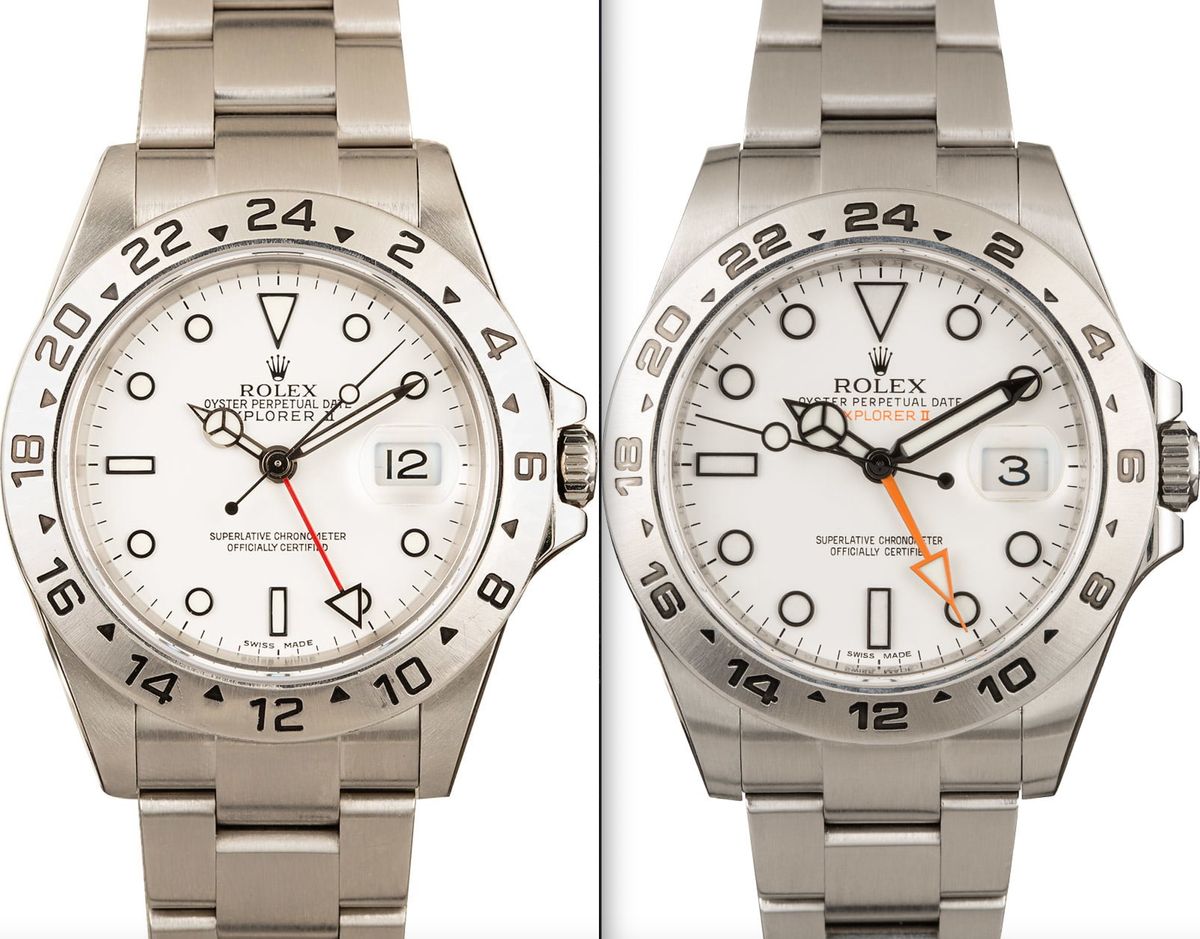Rolex Explorer II 16570 vs. 216570
Perhaps the most underrated Rolex sports watch today, overshadowed by giants such as the Submariner, Daytona, and GMT-Master II, the Explorer II is not one to overlook. Originally positioned as a tool watch for spelunkers that offered a day/night indication via its 24-hour hand and fixed 24-hour bezel, the Rolex Explorer II eventually graduated to GMT watch status with an independently adjustable 24-hour hand.
Since its introduction in 1971, there have only ever been four Rolex Explorer II references. If you're in the market for one of these sporty stainless steel models, join us as we compare two of the latest references, the Rolex Explorer II 16570 vs. 216570, to see which one suits you best.

Rolex Explorer II Design
Regardless of the specific reference, there are a handful of design traits that are common throughout all Explorer II watches. First, Rolex has only ever made the Explorer II in stainless steel; there have never been two-tone or solid gold references. Second, all Rolex Explorer II models are equipped with a fixed steel bezel engraved with a 24-hour scale. Third, like almost all Rolex watches with date displays, the Explorer II has a Cyclops magnification lens protruding from the crystal above the date window in dial. Finally, all Explorer II watches have a 24-hour hand to accompany the traditional hour, minute, and seconds hands.
On the maiden model, the Explorer II 1655, the 24-hour hand was coupled to the three other hands, and therefore functioned as an AM/PM indicator. On subsequent references, the arrow-tipped 24-hour hand could be set independently from the standard 12-hour hand to indicate a second timezone. Furthermore, while Rolex only fitted the Explorer II 1655 with a black dial, later models offered the choice between black or white dials. White dial versions are often referred to as "Polar" Explorer II watches.

The Evolution from 16570 to 216570
Rolex released the Explorer II ref. 16570 in 1989 to replace the preceding ref. 16550. Like its predecessor, the Explorer II 16570 featured a 40mm steel case, sapphire crystal, thin red arrow-tipped 24-hour hand, and a Mercedes-style handset. However, new to the model was the Caliber 3185 movement. Additionally, Rolex framed the lume plots on the Polar 16570 watches with black surrounds, which made the hour markers pop dramatically against the stark white background.
Over the next two decades of production, the Rolex Explorer II 16570 underwent a few enhancements. Most notably, Caliber 3185 was switched out for Caliber 3186 and tritium luminescence eventually made way for LumiNova and then Super-LumiNova. Moreover, similar to other models in Rolex's lineup in the mid-2000s, the Explorer II 16570 began receiving engraved rehauts and sapphire crystals that were laser etched with minuscule coronet insignias to combat counterfeiters.
To mark the 40th anniversary of the Explorer II in 2011, Rolex introduced Explorer II ref. 216570. While still sporting the familiar Explorer II style, Rolex made notable changes with the newest reference, such as a larger case, new movement, and a few other design modifications. The ref. 216570 is the biggest version of the Explorer II to date with a 42mm case. To accommodate the larger dimensions, Rolex also fitted the 216570 with broader hands, bigger indexes on the dial, and bolder engravings on the bezel. Also on the dial is the return of the fat orange 24-hand, which first appeared on the inaugural Explorer II 1665 but was eventually replaced by a thin red one on subsequent references. Plus, turn off the lights and you’ll see that the latest Explorer II 216570 glows blue in the dark instead of green thanks to it its Chromalight lume.
Another novelty of the Rolex Explorer II 216570 is its enhanced bracelet design, which now has solid center links and a sturdy folding Oysterlock safety clasp with an Easylink 5mm comfort extension system replacing the classic Fliplock clasp. Finally, inside the Explorer II 216570 is the Caliber 3187 movement, which is fitted with a Parachrom hairspring and Paraflex shock absorbers for even greater resistance to the knocks that come with adventuring.
Rolex Explorer II 16570 vs. 216570
While both models include stainless steel Oyster cases and Oyster bracelets, the option of black or white dials, and dual time functionality, if we compare the specs of the Explorer II 16570 vs. 216570, it's easy to see that there are plenty of differences between these two references.
Rolex Explorer II ref. 16570
- Production Years: 1989 - 2011
- Case Size: 40mm
- Dial: Black or White
- GMT Hand: Thin; Red
- Movement: 3185/3186; dual time + date
- Lume: Tritium/LumiNova/Super-LumiNova (glows green)
- Bracelet/Clasp: Hollow center links; Fliplock clasp
Rolex Explorer II ref. 216570
- Production Years: 2011 - Present
- Case Size: 42mm
- Dial: Black or White
- GMT Hand: Fat; Orange
- Movement: 3187; dual time + date
- Lume: Chromalight (glows blue)
- Bracelet/Clasp: Solid center links; Oysterlock safety clasp with Easylink extension

Which Rolex Explorer II Model to Buy?
Generally speaking, the newer ref. 216570 is bigger, bolder, and more aggressively designed than its classic older brother the ref. 16570. Depending on the example, the Explorer II 16570's price ranges from $6,500 - $7,500 on the secondary market. Conversely, the Explorer II 216570 retails for $8,350 but can generally be found pre-owned for a few hundred dollars less than that.
Given the current value of Rolex watches on the secondary market (particularly sports models), where paying above retail is becoming the norm, the Explorer II still offers great value. Which Explorer II do you prefer, the ref. 16570 or the ref. 216570? Let us know why in the comments below.
